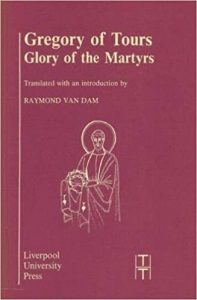Apocryphal Traditions in Gregory of Tours’ Glory of the Martyrs
I’ve spent the better part of the past two months polishing up my paper for the published proceedings of the Material of Christian Apocrypha conference that took place at the University of Virginia back in December 2018 (summary HERE and HERE). The paper is called “What They Brought Back Home: Pilgrimage Souvenirs as Transmitters of Christian Apocrypha.” From late antiquity and through the medieval period, pilgrims journeyed to various sacred sites—some of which are based purely on apocryphal traditions—and would hear stories associated with the saint and/or the site, see and touch its architectural and decorative features, participate in some kind of veneration, purchase one or more souvenirs (a token, a medal, or an ampulla, perhaps even a copy of text), and return home. There they might tell (or boast) about their experience and even proudly display their souvenirs.
 Some pilgrims wrote about their experiences, and plenty of these pilgrimage itineraries survive today, including Egeria and the Piacenza Pilgrim. One writer on pilgrimage who is frequently passed over in discussions of pilgrimage is Gregory of Tours (ca. 538–594 CE). Gregory is best known in our field as the (likely) author of an epitome of the Acts of Andrew, offering us vital information for what the original text, now mostly lost, contained. Gregory also wrote seven books relating stories of saints and miracles that they or their relics performed. One of these books is the Glory of the Martyrs (English trans. Raymond van Dan, Gregory of Tours: Glory of …
Some pilgrims wrote about their experiences, and plenty of these pilgrimage itineraries survive today, including Egeria and the Piacenza Pilgrim. One writer on pilgrimage who is frequently passed over in discussions of pilgrimage is Gregory of Tours (ca. 538–594 CE). Gregory is best known in our field as the (likely) author of an epitome of the Acts of Andrew, offering us vital information for what the original text, now mostly lost, contained. Gregory also wrote seven books relating stories of saints and miracles that they or their relics performed. One of these books is the Glory of the Martyrs (English trans. Raymond van Dan, Gregory of Tours: Glory of …
